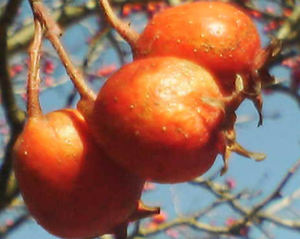
Pinyin: Shan Zha Latin: Crataegus Pinnatifida, Crataegus Oxyacantha, Crataegus Cuneata, Crataegus Korolkowii, Crataegus Pinnatifida Korolkowii, Mespilus Korolkowii
Common Name
Chinese Hawthorn, Hawthorn Fruit
Physical Characteristics
A decidious Tree growing to 7.5m. It is hardy to zone 6 and is not frost tender. It is in flower in May. The flowers are hermaphrodite (have both male and female organs) and are pollinated by Midges. The plant prefers light (sandy), medium (loamy) and heavy (clay) soils and can grow in heavy clay soil. The plant prefers acid, neutral and basic (alkaline) soils and can grow in very alkaline soil. It can grow in semi-shade (light woodland) or no shade. It requires moist or wet soil and can tolerate drought. The plant can tolerates strong winds but not maritime exposure. It can tolerate atmospheric pollution.*
Family
Edible Uses*
Edible Parts: Fruit. Fruit - raw or cooked. A pleasant flavour, it is sold in local markets in China. The fruit can be used in making pies, preserves, etc, and can also be dried for later use. A good size, it is up to 25mm in diameter. There are up to five fairly large seeds in the centre of the fruit, these often stick together and so the effect is of eating a cherry-like fruit with a single seed.*
Traditional Chinese Medicinal (TCM) Uses*
The fruits and flowers of hawthorns are well-known in herbal folk medicine as a heart tonic and modern research has borne out this use. The fruits and flowers have a hypotensive effect as well as acting as a direct and mild heart tonic. They are especially indicated in the treatment of weak heart combined with high blood pressure. Prolonged use is necessary for it to be efficacious. It is normally used either as a tea or a tincture. The fruits are anticholesterolemic, cardiotonic, stomachic and vasodilator. Their use improves the blood circulation and lowers blood pressure. The fruits are used in the treatment of dyspepsia, stagnation of fatty foods, abdominal fullness, retention of lochia, amenorrhoea, postpartum abdominal pain, hypertension and coronary heart disease.*
References
Source: Crataegus Pinnatifida Major - Crataegi Fructus Plants For A Future, England 1996-2008.
This work is licensed under a Creative Commons License.
Natural dietary supplements are designed to offer the body support to promote health, harmony, balance and overall well being.*

 Get Well Natural, LLC
Get Well Natural, LLC  Kidney Function & Regeneration Health
Kidney Function & Regeneration Health  Platelet & Blood Cell Health
Platelet & Blood Cell Health  Prostate, Flow & Function Health
Prostate, Flow & Function Health  General Mind & Body Health
General Mind & Body Health  Heart, Cholesterol & Cardio Health
Heart, Cholesterol & Cardio Health  Allergy-Free Body
Allergy-Free Body  Anxiety & Stress
Anxiety & Stress  Blood Platelet Counts & Function
Blood Platelet Counts & Function  Blood Pressure Health
Blood Pressure Health  Kidney Function Health
Kidney Function Health  Immune System Health & Balance
Immune System Health & Balance  Prostate & Urinary Health Function
Prostate & Urinary Health Function  Blood Sugar Balance
Blood Sugar Balance  Cardiovascular Heart Health
Cardiovascular Heart Health  Detoxification & Healthy Cells
Detoxification & Healthy Cells  Women's Health
Women's Health  Liver Regeneration
Liver Regeneration  Pain-Free Body
Pain-Free Body  Water & Air Filtration
Water & Air Filtration 


